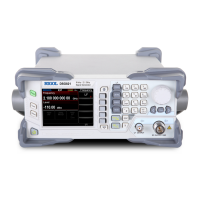Chapter 2 Performance Verification Test RIGOL
DSG800 Performance Verification Guide
2. Configure DSG800:
a) Set the frequency to 1 GHz.
b) Set the amplitude to -10 dBm.
c) Turn on the RF output switch RF/on.
d) Select FM modulation.
e) Turn on the FM switch.
f) Set the modulation source to internal.
g) Set the modulation frequency deviation to 50 kHz.
h) Set the modulation rate to 1 kHz.
i) Set the modulation waveform to Sine.
j) Turn on the modulation output switch Mod/on.
3. Configure the signal analyzer:
a) Set the center frequency to 1 GHz.
b) Set the span to 200 kHz.
c) Set the reference level to 0 dBm.
d) Set the input attenuation to 10 dB.
e) Set the resolution bandwidth to 1 kHz.
f) Set the video bandwidth to 1 kHz.
g) Set the sweep time method to accurate.
h) Select FM analog demodulation.
4. Press Meas Setup Auto Scale on the signal analyzer and read the results of the
demodulated signal in the FM analog demodulation test interface of the signal analyzer.
Record the measurement results of (Pk - Pk) / 2 and Distortion.
Note: (Pk - Pk) / 2 represents the peak of the low frequency signal after FM demodulation.
5. Calculate the modulation accuracy and the distortion using the formulas: Modulation
Accuracy = |(Pk - Pk) / 2 - 50 kHz|, Distortion = Distortion Value. Then, compare
the calculation results with the specifications.
Test Record Form
DSG800 Output
Frequency
Item
Measurement
Value
Calculation
Result
Limit
Pass/
Fail
1 GHz
Modulation
Accuracy
[1]
< Modulation Frequency
Deviation Setting × 2% + 20 Hz
Distortion
[2]
< 2% (typ.)
Note:
[1] Modulation Accuracy = |(Pk - Pk) / 2 - 50 kHz|
[2] Distortion = Distortion Value in the FM Analog Demodulation Test Interface

